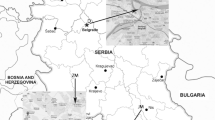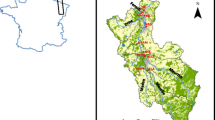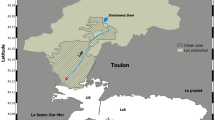Abstract
A total of 42 aquatic particulate sample:, (suspended matter and < 63 μm surficial sediments) was collected from 11 large rivers in eastern China. Contents of both major elements (Al, Si, Ca, Mg, K, Na, Ti, Fe, Mn) and trace elements (Cu, Pb, Zn, Cd, Cr, Co, Ni, V) in the particulate samples were analyzed. The geographic variations of river particulate compositions were studied. The results showed that the Yellow River particulates contained a notably high content of Ca and a low content of Al. Except for the Yellow River, A1 contents in particulates increased from the northern rivers to the southern rivers, while K and Na decreased. Trace elements were relatively enriched in the southern river particulates. The geographic variations seemed to be related to the weathering types and geological background within the river basins. The average composition of river particulates in China was then estimated. Based on the Chinese river data from this paper, as well as on the literature data for other main world rivers, a new estimation of the global average particulate composition was reported. Since the earlier estimations in the literature were not concerned with or at best concerned only with few of the Chinese rivers which contribute a major proportion to the global load of river particulates, this new estimation may be more reasonable.
Similar content being viewed by others
References
Chapman, D. (ed.): Water quality assessments. Chapman & Hall, London 1992.
Chen, J.; Wang, F.; Chen, J.: Relation of aquatic particulate grain size to heavy metals concentrations in the eastern Chinese rivers. Acta Scentiae Circumstantiae 14, 419–425 (1994) (in Chinese).
Chen, J.; Wei, F.; Wu, Y.: Background concentrations of elements in soils of China. Water, Air, and Soil Pollution 57/58, 699–712 (1991).
Degens, E. T.; Kempe, S.; Richey, J. E. (ed.): Biogeochemistry of major world rivers, SCOPE 42. Wiley, Chichester 1991.
Garrels, M.; Mackenzie, F. T.: Evolution of sedimentary rocks. Norton, New York 1971.
Gibbs, R. J.: Transport phases of transition metals in the Amazon and Yukon rivers. Geol. Soc. Am. Bull. 88, 829–843 (1977).
Gordeev, V. V.; Lisitzin, A. P.: Average chemical composition of suspended matter in world river and river inputs to the oceans. Dokl. Akad. Nauk. SSSR 238, 225–228 (1978).
Horowitz, A. J.; Elrick, K. A.: Interpretation of bed sediment trace metal data: methods for dealing with the grain size effect. In: Lichtenberg, J. J., Winter, J. A.; Weber, C. I.; Fradkin, L. (ed), Chemical and biological characterization of sludges, sediments, dredge spoils, and drilling muds, pp. 114–128. ASTM STP 976. Philadelphia. 1988.
Huang, W. W.: Heavy metals and their geochemical behaviors in the mouth of the Yellow River. In: Chen, J.; Zhou, J. (ed.), Heavy metals in the aquatic environment in China, pp. 231–270. China Environmental Sciences Press, Beijing 1992.
Li Y.-H.; Teraoka, H.; Yang, T.-S.; Chen J.: The elemental composition of suspended particles from the Yellow and Yangtze Rivers. Geochimica of Cosmochimica Acta 48, 1561–1564 (1984).
Martin J.,M.; Kulbicki, G.; De Groot, A.J.: Terrigenous supply of radioactive and trace elements to the ocean. Proc. 1st Symp. Hydrogeochem Biogeochem, Tokyo 1973.
Martin, J. M.; Meybeck M.: Elemental mass-balance of material carried by world major rivers. Marine Chem 7, 173–206 (1979).
Martin, J. M.; Whitfield, J.M.: The significance of the river input of chemical elements to the ocean. In: Wong, C.S. (ed.), Trace metals in seawater, pp. 265–296. Plenum Press, Erice 1983.
Meybeck, M.: Total mineral dissolved transport by world major rivers. Hydrol. Sci. Bull. 21, 265–284 (1976).
Meybeck, M.: How to establish and use world budgets of riverine materials. In: Lerman A., et al. (ed.), Physical and chemical weathering in geochemical cycles, pp. 247–272. Kluwer Academy Publisher, Dordrecht. 1988.
The Ministry of Irrigation and Electric Power (MIEP), P. R. China: Assessment of water resources in China. China Irrigation Press, Beijing 1987 (in Chinese).
Milliman, J. D.; Meade, R. H.: World-wide delivery of river sediment to the oceans. J. Geology 91, 1–21 (1983).
Moore, W. S.: Amazon and Mississippi river concentrations of uranium, thorium and titanium isotopes. Earth Planet. Sci. Lett. 2, 231–234 (1967).
Morozov, N. P.: Geochemistry of the alkali metals in rivers. Geokhimiya 6, 729–739 (1969).
Qu, C.; Yan, R.: Chemical composition and factors controlling suspended matter in three major Chinese rivers. Sci. Total Environ. 97/98, 335–346 (1990).
Strakhov, N.M.: Principles of Lithogenssis, Part 1, Chapter 1. Consultants Bureau and Oliver and Boyd, Edinburgh 1967. Thomas, R.; Meybeck, M.: The use of particulate material, In: Chapman, D. (ed.), Water quality assessments, pp. 121–170. Chapman & Hall, London 1992.
Trefry, J. H.; Presley, B. J.: Heavy metal transport from the Mississippi River to the Gulf of Mexico. In: Windom, H. L., et al. (ed.), Marine pollutants transfer, pp. 39–76. Lexington Books, Lexington 1976.
Turekian, K. K.; Wedepohl, K. H.: Distribution of the elements in some major units of the earth's crust. Bull. Geol. Soc. Am. 72, 175–192 (1961).
Turekian, K. K.; Scott, M.: Concentrations of Cr, Ag, Mo, Ni, Co and Mn in suspended material in streams. Environ. Sci. Technel. 1, 940–942 (1967).
Wagemann, R.; Brunskill, G. J.; Graham, B. W.: Composition and reactivity of some river sediments from the Mackenzie Valley, NWT. Canada. Environ. Geol. 1, 349–358 (1977).
Zhang, J.; Martin, J. M.; Thomas, A. J.; Nirel, P.: Fate of the particulate elements in the Changjiang Estuary and the east China Sea. In: Yu, G. et al. (ed.), Biogeochemical study of the Chaulgjiang Estuary, pp. 220–244. China Ocean Press, Beijing 1990a.
Zhang, J.; Huang, W. W.; Shi, M. C.: Huanghe (Yellow River) and its estuary: Sediment origin, transport and deposition. J. Hydrology 120, 203–223 (1990).
Zhang, J.; Huang, W. W.; Liu, M. G.; Zhou, Q.: Drainage basin weathering and major element transport of two large Chinese rivers (Huanghe and Changjiang). J. Geographical Research 95(C8), 13277–13288 (1990).
Author information
Authors and Affiliations
Rights and permissions
About this article
Cite this article
Chen, J., Wang, F. Chemical composition of river particulates in eastern China. GeoJournal 40, 31–37 (1996). https://doi.org/10.1007/BF00222528
Received:
Accepted:
Issue Date:
DOI: https://doi.org/10.1007/BF00222528




